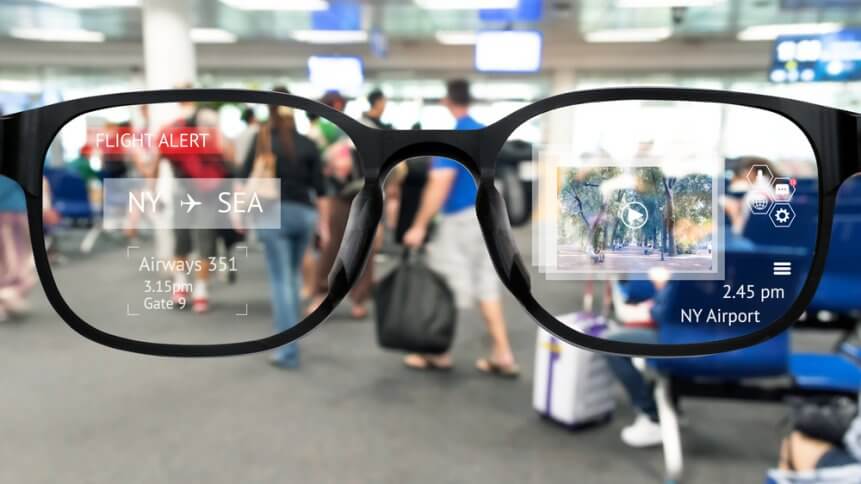Apple thinks AR glasses will replace smartphones

Back in 2015, Wired dared to predict that within a few years, a smartphone would be the only computer that most people would need.
The following year, mobile browsing overtook desktop for the first time. A quick look around at your immediate surroundings today will reveal everyone staring down into the screens of the smartphones as they create, consume, and share content.
For the most part, businesses have now adjusted to life in a mobile-first world.
Mobile apps and mobile-friendly websites have long been the norm. The arrival of the experience economy is helping the space move towards progressive web apps. But where do we go from here?
If the tech companies have their way, the end of the smartphone could arrive sooner than you think.
AR 2.0
The lines between online and offline are not only blurred but are increasingly being wiped away. Augmented Reality (AR) is leading the charge to tear down the barrier once and for all by overlaying digital objects onto the real world.
But Apple is also exploring extended reality (XR) that will combine the best of both worlds with an AR and VR headset.
According to a recent report in The Information, Apple is aiming to replace the iPhone within the next decade. Although nothing has officially been announced, attendees at the secret event advised that Apple’s first device will arrive in 2022 and is similar in appearance to the Oculus Quest VR headset.
However, the device that will move Apple towards its goal of replacing the iPhone is not expected to drop until 2023. The device is expected to look much more like a pair of sunglasses and will be intended for all-day use rather than a bulky immersive VR headset.
The AR glasses are expected to overlay information into the real world. In a nutshell, your field of vision will instantly be upgraded as directions, offers, attractions, and highly rated restaurants are automatically available.
Hopefully, this can all be delivered without you walking into a lamp post.
Before you dismiss the concept, make no mistake that the race to replace the phone in your pocket is already underway. Microsoft, Amazon, Google, Facebook, and Magic Leap are all working on reducing the size and cost of smart glasses that will increase adoption.
Many will remember the moment when Google Glass arrived in 2013 to similar fanfare. Early-adopting techies paid $1,500 for the privilege of wearing the aesthetically unappealing AR glasses in exchange for being labeled an ‘Explorer’ by Google. Meanwhile, privacy concerned citizens branded wearers ‘Glassholes.’
The world wasn’t ready for Google Glass in 2013. But has this changed? A walk around any city in the world will involve carefully navigating pavements filled with selfie sticks and Instagrammers that all have the same motto of ‘If we don’t record it, it never happened.’
It feels like we are ready for something that enhances our experiences and is useful without crossing the line of being creepy. But what does AR mean for businesses?
YOU MIGHT LIKE

IKEA AR app could be a catalyst for its evolution
The smartphone’s uncertain future
Grasping the business benefits of emerging technologies such as AR and VR is much more about upgrading your mindset than technology. Everything from product demos that enable customers to try before they buy, to increase interaction and engagement can be brought to life by AR and mixed reality applications as multi experiences become the norm.
Extending the shopping experience when choosing a pair of running shoes or Ikea furniture can help retailers increase revenue. AR can also help improve your employee’s soft skills and create more engaging training programs. The apps and software are already here, but it’s only when there’s an affordable device for everyone, not just the few, will we see it enter the mainstream.
We are already living in an age of instant gratification where we can access information on-demand using just our voice. As we grow increasingly impatient with slow and traditional methods of getting things done, we will naturally continue to tear down the barriers between online and offline.
Twelve years ago, Apple unveiled what many believed to be a game-changer moment with the iPhone.
But, is it time to admit that the smartphone has run its course as the industry struggles to add new features to keep us upgrading our handsets? Although I recently declared that mobile VR is dead, maybe I should have been clearer in saying that it’s the smartphone that has an uncertain future rather than VR.
Apple and the usual suspects in tech are all united on propelling the market forward and progressing beyond smartphones. As AR merges with our perception of the physical world, it seems that our future will consist of mixed reality.
Advances in technology look set to enhance our perception of reality. One of the biggest stumbling blocks the industry will need to overcome is the sharing of different experiences in a shared environment.
If our personalized data is creating unique experiences for a group of friends in the same location, could we run the risk of losing sync with each other in reality?
Here in 2019, we are just beginning to see the foundations and the building blocks of a brave new digital world without a smartphone. Business leaders will be keeping a close eye on what the next ten years will bring and prepare to enter another period of transformational change — a new era where even your perception of reality is questioned.








